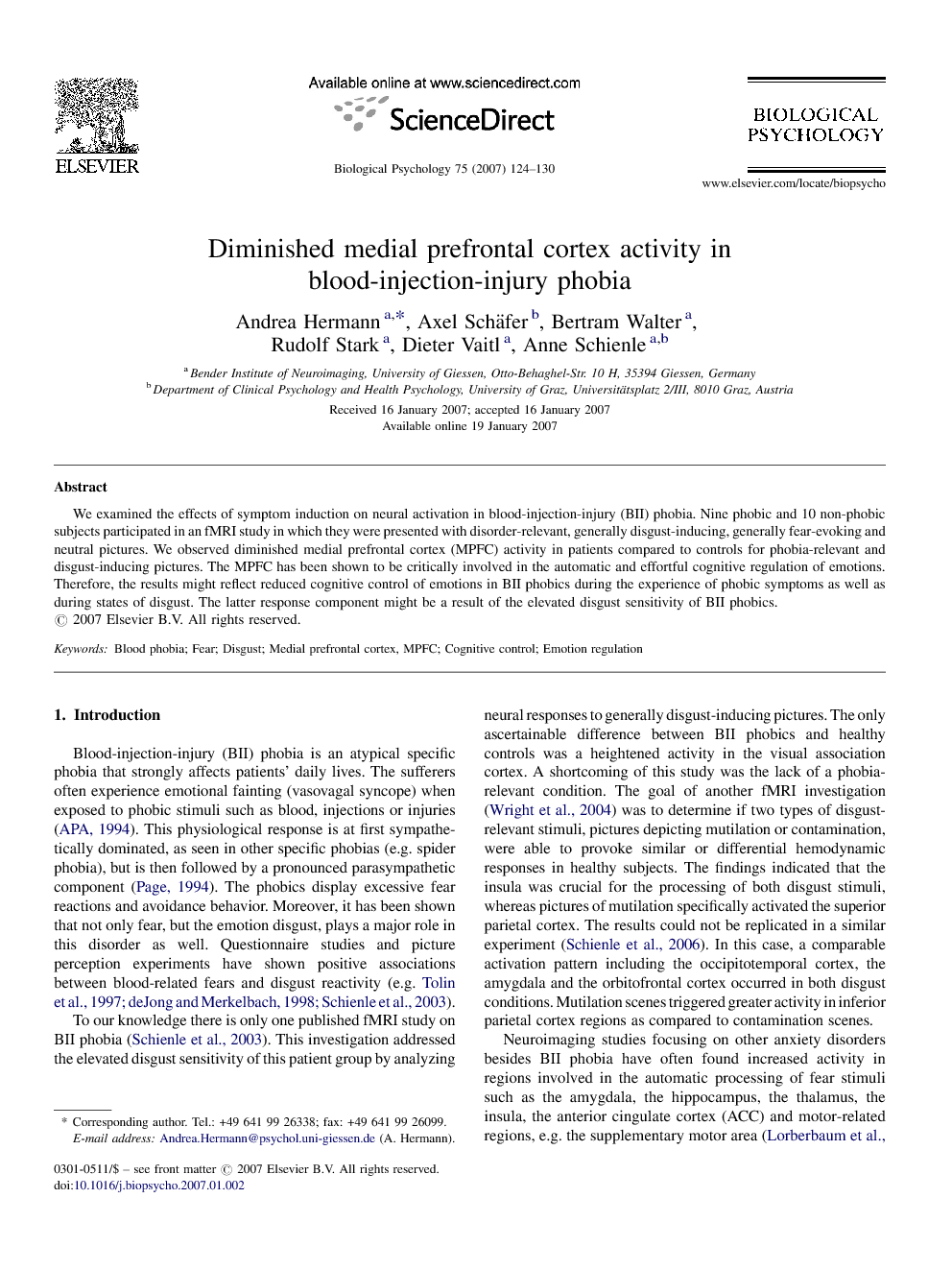We examined the effects of symptom induction on neural activation in blood-injection-injury (BII) phobia. Nine phobic and 10 non-phobic subjects participated in an fMRI study in which they were presented with disorder-relevant, generally disgust-inducing, generally fear-evoking and neutral pictures. We observed diminished medial prefrontal cortex (MPFC) activity in patients compared to controls for phobia-relevant and disgust-inducing pictures. The MPFC has been shown to be critically involved in the automatic and effortful cognitive regulation of emotions. Therefore, the results might reflect reduced cognitive control of emotions in BII phobics during the experience of phobic symptoms as well as during states of disgust. The latter response component might be a result of the elevated disgust sensitivity of BII phobics.
Blood-injection-injury (BII) phobia is an atypical specific phobia that strongly affects patients’ daily lives. The sufferers often experience emotional fainting (vasovagal syncope) when exposed to phobic stimuli such as blood, injections or injuries (APA, 1994). This physiological response is at first sympathetically dominated, as seen in other specific phobias (e.g. spider phobia), but is then followed by a pronounced parasympathetic component (Page, 1994). The phobics display excessive fear reactions and avoidance behavior. Moreover, it has been shown that not only fear, but the emotion disgust, plays a major role in this disorder as well. Questionnaire studies and picture perception experiments have shown positive associations between blood-related fears and disgust reactivity (e.g. Tolin et al., 1997, deJong and Merkelbach, 1998 and Schienle et al., 2003).
To our knowledge there is only one published fMRI study on BII phobia (Schienle et al., 2003). This investigation addressed the elevated disgust sensitivity of this patient group by analyzing neural responses to generally disgust-inducing pictures. The only ascertainable difference between BII phobics and healthy controls was a heightened activity in the visual association cortex. A shortcoming of this study was the lack of a phobia-relevant condition. The goal of another fMRI investigation (Wright et al., 2004) was to determine if two types of disgust-relevant stimuli, pictures depicting mutilation or contamination, were able to provoke similar or differential hemodynamic responses in healthy subjects. The findings indicated that the insula was crucial for the processing of both disgust stimuli, whereas pictures of mutilation specifically activated the superior parietal cortex. The results could not be replicated in a similar experiment (Schienle et al., 2006). In this case, a comparable activation pattern including the occipitotemporal cortex, the amygdala and the orbitofrontal cortex occurred in both disgust conditions. Mutilation scenes triggered greater activity in inferior parietal cortex regions as compared to contamination scenes.
Neuroimaging studies focusing on other anxiety disorders besides BII phobia have often found increased activity in regions involved in the automatic processing of fear stimuli such as the amygdala, the hippocampus, the thalamus, the insula, the anterior cingulate cortex (ACC) and motor-related regions, e.g. the supplementary motor area (Lorberbaum et al., 2004, Schienle et al., 2005 and Kim and Gorman, 2005). Also, a decreased activation in prefrontal cortex regions has frequently been observed (Kim and Gorman, 2005). The latter component might reflect a deficit in cognitive control during excessive states of anxiety. This could possibly lead to reduced inhibitory regulation of limbic regions such as the amygdala. Especially, the medial prefrontal cortex (MPFC) and the ACC are assumed to have specific functions in cognitive and self-referential processing as well as in emotion modulation (Phan et al., 2004). Taking this into account, it is likely that abnormal activity in MPFC areas might be an important characteristic of anxiety disorders (LeDoux, 2002). Furthermore, neuroimaging studies on cognitive regulation of emotions in healthy subjects have shown that these prefrontal areas are involved in different kinds of cognitive control of emotions, for instance reappraisal, anticipation and attention distraction (Ochsner and Gross, 2005).
The main goal of the present study was to identify the neural correlates of phobic states in BII phobics. We hypothesized that the presentation of blood-related pictures would activate regions important for the automatic processing of emotions (e.g. the amygdala). This should apply to both patients and non-phobic control subjects due to the overall emotional relevance of this stimulus type. The activation, however, should be greater in patients than controls. Further, the smaller capacity of phobics to cognitively regulate affective responses during the exposure should be mirrored in a reduced activation of prefrontal cortex regions relative to controls. Moreover, we hypothesized that phobic compared to healthy subjects would show an elevated disgust sensitivity and stronger hemodynamic responses towards disgust-inducing disorder-irrelevant pictures (e.g. in the amygdala). A fear condition with threatening, but non-phobic pictures served as a further emotional control condition.
This is the first fMRI study on symptom provocation in BII phobia. We observed decreased activation in medial prefrontal cortex areas towards phobic pictures in phobic compared to control subjects. Since this brain region is critically involved in the cognitive regulation of emotions, we assume that BII phobia is characterized by a disturbance of this mechanism during exposure. Furthermore, BII phobics showed reduced activity in the VMPFC in response to generally disgust-inducing pictures, which might be related to their elevated disgust sensitivity. Future studies on BII phobia in particular and anxiety disorders in general should focus on a more detailed analysis of possible deficits in the cognitive regulation of emotions.


